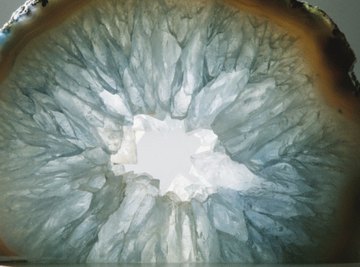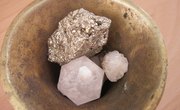
A crystal growing experiment can give students deepened understanding of how mineral crystals grow. Popcorn rock is a naturally occurring light weight, aragonite limestone crystal found at some outcrops in the Great Basin of the western United States. The popcorn-like crystals are formed from limestone formations. Students can try various experiments using this rock. Growing crystals is not only easy, but also fun and educational.
Growing Popcorn Rock Crystals
The students can collect some pieces of popcorn rocks and produce a healthy new crop of popcorn crystals. They just need to put the popcorn rock in a clear glass bowl and add enough white distilled vinegar to completely cover them. The existing crystals act as seeds, and new crystals begin to form within one to three weeks. If proper care is given, the popcorn crystals will last for years.
Crystal Decay
The students can do a comparative experiment using popcorn crystals and show how humans can destroy crystal formations by a single touch. Popcorn rock forms into beautiful crystal as the vinegar evaporates from the bowl. Students can take two dishes of popcorn rocks, and allow classmates to touch the rocks in one bowl while safeguarding another bowl from any human contact. Students will observe that crystal formations can be affected by human touch. The oils in the students' fingers slowly destroy the crystals in one dish, while the untouched crystals are unaffected.
Popcorn Rock Chemistry
After watching the popcorn rocks grow, students can learn more about geology, chemistry and the process of a chemical reaction by writing a report on the chemical reaction that creates the popcorn like crystals. Students can try to grow crystals in other types of acids, and discuss which one works the best. Students should be able to discuss why this particular rock reacts to form crystals, while other limestone and quartz crystals do not. By investigating the chemical reaction, students will deepen their knowledge of the popcorn rock crystals, and how the earth forms different chemicals.
Crystal Growth Comparison
The students can observe the effects of popcorn rock in vinegar solution, and apply different variables to the crystals as they grow to see how the environment around the crystals affects their growth. Students can change some of the variables like keeping the glass bowl sealed or open and compare the results on the crystal's growth. Students can also place the bowl in light or dark locations to grow popcorn crystals. As the crystals grow, students can record any differences between the sample's growth, and report on which conditions are more favorable for crystal growth after the results are recorded.
References
About the Author
Since 2003, Timothy Burns' writing has appeared in magazines, management and leadership papers. He has contributed to nationally published books and he leads the Word Weavers of West Michigan writers' group. Burns wrote "Forged in the Fire" in 2004, and has published numerous articles online. As a trained conference speaker, Burns speaks nationally on the art, science and inspiration of freelance writing.
Photo Credits
Hemera Technologies/Photos.com/Getty Images
